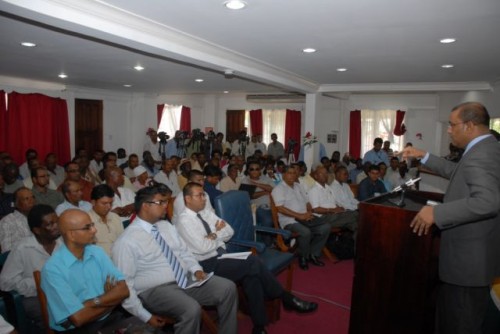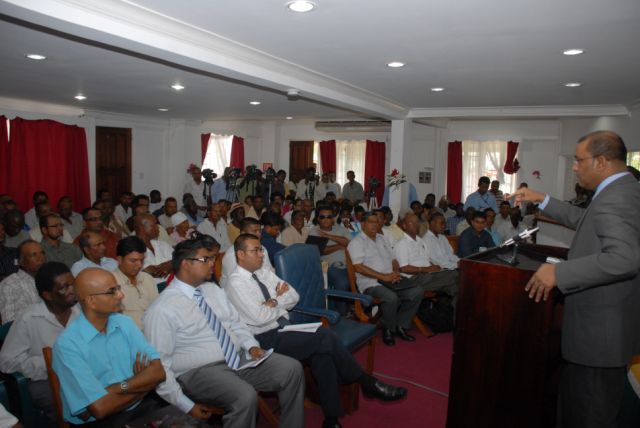As a parched Guyana struggles in El Nino’s dry grip, President Bharrat Jagdeo has promised to visit areas along the coast affected by the weather phenomenon to assess the situation even as he said that the administration is doing its utmost to assist affected farmers.
Speaking to stakeholders at a forum where El Nino and the administration’s response to the conditions were addressed at the Cheddi Jagan Research Centre, High Street, Kingston yesterday, Jagdeo said the situation is being assessed and the relevant agencies are responding in that regard.
He said dealing with the effects of El Nino will require a national effort, noting that the authorities have no clue as to when the conditions will change and as such current efforts to cushion the effects are being made as if the dry weather conditions will be experienced for a long time.

The President said the relevant authorities are working with communities in terms of priority, addressing the impacts of El Nino on water for human consumption with the needs for economic purposes next in line.
He said he will be visiting the Essequibo Coast this weekend to look at the effects on that area, noting that he is also expected to visit other areas in other affected administrative regions.
Chief Hydromet Officer Bhaleka Seulall told the gathering earlier that the current 2009-2010 El Nino phenomenon, has seen reduced rainfall in the months of April and November 2009 and January this year in all ten administrative regions with the exception of a few “insignificant showers” which were experienced along the Essequibo Coast a few weeks ago. She said that the weather phenomenon, based on current observations, is expected to continue until April.
As such Seulall made an appeal for consumers across Guyana to carefully monitor the use of water resources.
Head of the National Drainage and Irrigation Authority (NDIA) Lionel Wordsworth told those gathered, including Agriculture Minister Robert Persaud, rice farmers from along the coastland and other relevant agency representatives that the NDIA has made several interventions along the coast to remedy the effects of the situation. He noted, however, that with no rainfall being experienced, several areas where such interventions have been made have seen water utilized from sources decreasing to low levels. Wordsworth highlighted several areas which have been feeling the brunt of the dry season including rice farms along the Essequibo Coast, parts of Region Three between Leonora and Nismes as well as several areas in Region Five.
One such area in Region Two where efforts were made to source water is swamp land behind the Essequibo Coast village of Lima, where the NDIA has been able to carry out irrigation works to drain water into the main canals to furnish rice farms between the Pomeroon River area and Somerset & Berks on the Essequibo coast.
Further south of this area, close to the Ituribisi Lake, water being sourced from the latter has been assisting farmers there.
Wordsworth also stated that while water is being sourced from the Pomeroon River through the Dawa pump station, the salinity content of water within the Pomeroon has increased, a development, which he noted, will affect the services offered by the pump.
According to the NDIA, interventions in Region Two have seen irrigation services being provided by the operation of the Dawa pumps, the Capoey Lake, Lake Mainstay and the Golden Fleece conservancy for approximately 32,000 hectares of mainly rice lands and for other crops.
Among the works carried out in Region Three are excavation of the Greenwich Park irrigation canal, irrigation pumps being installed at Philadelphia and Ruby to re-circulate water, as well as excavation currently being undertaken to construct ponds for cattle at Leguan.
Regions Four and Five have seen similar interventions, as irrigation pumps have been installed at critical areas while excavation has also been undertaken in those areas. The Guyana Sugar Corporation (GuySuCo) is also assisting with the efforts to cushion El Nino effects with interventions in Regions Three and Six. Drinking water has been guaranteed in light of the current dry conditions in Region Five, the NDIA noted.
According to the MoA, present operating levels in the main water conservancies have been below the Dead Storage Level (DSL), which is the minimum level in the holding areas.
In the East Demerara Water Conservancy (EDWC), Present Level (PL) is at 51.95 Georgetown Datum (GD) against a DSL of 55.50 GD; in the Boeraserie Conservancy PL is at 53.60 GD against DSL 55.50 GD; at the MMA Conservancy, PL is 56.92 GD against DSL of 59.5GD.
The present El Nino conditions have seen generally near-average to below average rainfall being experienced over most of Guyana. According to the MoA, the agency is making every effort to mitigate losses in the vicinity of $3 billion worth of crops and livestock which are in danger.

